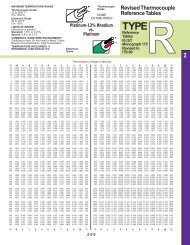Using Thermocouples
Using Thermocouples
Using Thermocouples
Create successful ePaper yourself
Turn your PDF publications into a flip-book with our unique Google optimized e-Paper software.
Reference Circuit<br />
Let’s replace the ice bath with another isothermal<br />
block<br />
HI<br />
LO<br />
Voltmeter<br />
Cu<br />
Cu<br />
J 3<br />
J 4<br />
Isothermal Block<br />
The new block is at Reference Temperature TREF, and<br />
because J 3 and J 4 are still at the same temperature, we<br />
can again show that<br />
V = α (T 1 -T REF )<br />
This is still a rather inconvenient circuit because we<br />
have to connect two thermocouples. Let’s eliminate the<br />
extra Fe wire in the negative (LO) lead by combining the<br />
Cu-Fe junction (J 4 ) and the Fe-C junction (J REF ).<br />
We can do this by first joining the two isothermal<br />
blocks (Figure 9b).<br />
Fe<br />
J REF<br />
Fe<br />
ELIMINATING THE ICE BATH<br />
Figure 9a<br />
C<br />
J 1<br />
T REF Isothermal Block<br />
This is a useful conclusion, as it completely eliminates<br />
the need for the iron (Fe) wire in the LO lead:<br />
+<br />
v<br />
–<br />
Cu<br />
Cu<br />
J 3<br />
J 4<br />
Again, V = α (TJ 1 - T REF ), where α is the Seebeck<br />
coefficient for an Fe-C thermocouple.|<br />
Junctions J 3 and J 4 , take the place of the ice bath.<br />
These two junctions now become the Reference<br />
Junction.<br />
Now we can proceed to the next logical step: Directly<br />
measure the temperature of the isothermal block (the<br />
Reference Junction) and use that information to<br />
compute the unknown temperature, TJ 1 .<br />
Fe<br />
C<br />
T REF<br />
EQUIVALENT CIRCUIT<br />
Figure 11<br />
J 1<br />
Cu<br />
HI<br />
Fe<br />
J<br />
J 1<br />
3<br />
LO +<br />
Cu<br />
Fe<br />
C<br />
v<br />
J<br />
–<br />
4 J REF<br />
Isothermal Bloc k @ T REF<br />
JOINING THE ISOTHERMAL BLOCKS<br />
Figure 9b<br />
We haven’t changed the output voltage V. It is still<br />
V = α (TJ 1 - TJ REF )<br />
Now we call upon the law of intermediate metals (see<br />
Appendix A) to eliminate the extra junction. This<br />
empirical “law” states that a third metal (in this case,<br />
iron) inserted between the two dissimilar metals of a<br />
thermocouple junction will have no effect upon the<br />
output voltage as long as the two junctions formed by<br />
the additional metal are at the same temperature:<br />
Metal A<br />
Isothermal Connection<br />
Thus the low lead in Fig. 9b: Becomes:<br />
Cu<br />
Metal C<br />
Metal B =<br />
C<br />
Fe =<br />
T REF<br />
Metal A<br />
Cu<br />
LAW OF INTERMEDIATE METALS<br />
Figure 10<br />
Metal C<br />
T REF<br />
C<br />
Z-23<br />
Voltmeter<br />
Cu<br />
Cu<br />
J 3<br />
R T<br />
J 4<br />
Block Temperature = T REF<br />
EXTERNAL REFERENCE JUNCTION-NO ICE BATH<br />
Figure 12<br />
A thermistor, whose resistance R T is a function of<br />
temperature, provides us with a way to measure the<br />
absolute temperature of the reference junction.<br />
Junctions J 3 and J 4 and the thermistor are all assumed<br />
to be at the same temperature, due to the design of the<br />
isothermal block. <strong>Using</strong> a digital multimeter under<br />
computer control, we simply:<br />
1) Measure R T to find T REF and convert T REF<br />
to its equivalent reference junction<br />
voltage, V REF , then<br />
2) Measure V and subtract V REF to find V 1 ,<br />
and convert V 1 to temperature T J1 .<br />
This procedure is known as Software Compensation<br />
because it relies upon the software of a computer to<br />
compensate for the effect of the reference junction. The<br />
isothermal terminal block temperature sensor can be<br />
any device which has a characteristic proportional to<br />
absolute temperature: an RTD, a thermistor, or an<br />
integrated circuit sensor.<br />
It seems logical to ask: If we already have a device<br />
that will measure absolute temperature (like an RTD or<br />
thermistor), why do we even bother with a thermocouple<br />
that requires reference junction compensation? The<br />
Fe<br />
C<br />
+<br />
V 1<br />
–<br />
J 1














